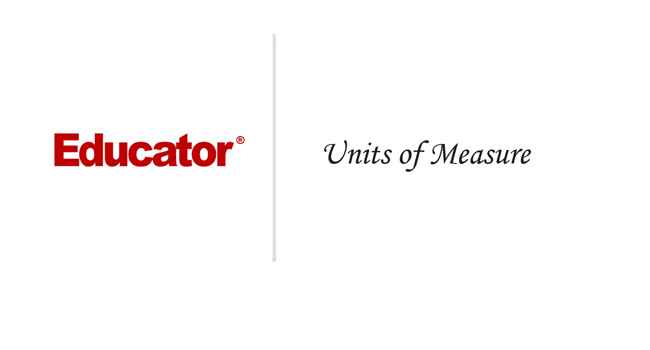Click video to play

This is a quick preview of the lesson. For full access, please Log In or Sign up.
For more information, please see full course syllabus of Basic Math
For more information, please see full course syllabus of Basic Math
Basic Math Units of Measure
Lecture Description
In this lesson our instructor talks about units of measure. She explains in depth about the measurement of length such as feet, inches, yard, mile, millimeters, centimeters, and meters. She talks in depth about the measurement of mass such as pounds, ounces, tons, grams, and kilograms. She also discusses the measurement of liquid such as gallons quarts pints and cups. Four complete extra example videos round up this lesson.
Bookmark & Share
Embed
Share this knowledge with your friends!
Copy & Paste this embed code into your website’s HTML
Please ensure that your website editor is in text mode when you paste the code.(In Wordpress, the mode button is on the top right corner.)
×
Since this lesson is not free, only the preview will appear on your website.
- - Allow users to view the embedded video in full-size.
Next Lecture
Previous Lecture










































 Answer Engine
Answer Engine



1 answer
Last reply by: Hubery Yang
Thu Oct 1, 2020 7:55 AM
Post by Sunil Basavanahalli on September 29, 2020
thx so much!!?(´?`???)
1 answer
Last reply by: Johnathon Kocher
Thu Apr 7, 2016 10:35 AM
Post by peter yang on April 21, 2014
how much yard is = to 1 mile?
0 answers
Post by Milan Ray on April 18, 2014
If cm means 100 In a small way and mm means1000 in a small way what does meter mean
1 answer
Last reply by: Milan Ray
Fri Apr 18, 2014 2:41 PM
Post by Habibo Ali on February 10, 2014
every time a try to lisint lecture it stops i don;t know why?
1 answer
Last reply by: Milan Ray
Fri Apr 18, 2014 2:42 PM
Post by Shane Paulino-Inoa on January 12, 2014
The big ''G'' diagram really helped me remember the liquid measurement system. :)
0 answers
Post by Leif Djurhuus on August 21, 2013
wow, happy we use the meter version :)
2 answers
Last reply by: Hubery Yang
Thu Oct 1, 2020 7:57 AM
Post by Jeanette Akers on October 22, 2012
The story David refers to goes along with the Big G that Intructor Pyo drew for liquid measurement. The stores states the following: Once in the Kingdom of Gallon there lived four Queens. (The 4 Queens Ms. Pyro drew inside the Big G represent 4 quarts.) Each Queen had a Prince and Princess. (The 2 PS Ms. Pyro drew inside each Q represent 2 Pints.) Each Prince and Princess had two cats. (The two C's that Ms. Pyo drew inside each P represent cups.) The Horizontal line that Ms.Pyo drew on the G shows the division for a half gallon. This story and picture are sometimes taught to 3rd or 4th grade students as a memory device.
0 answers
Post by David Nelson on April 30, 2012
in school, they have something they do to help kids. it goes" in the land of giants(gallons) their lived 4 queens(quarts) each queen had a prince and a princess ( the 2 pints), each prince and princess had 2 children( the 4 cups, 2 for each prince and princess!)
0 answers
Post by Chandra Green on March 13, 2012
Excellent